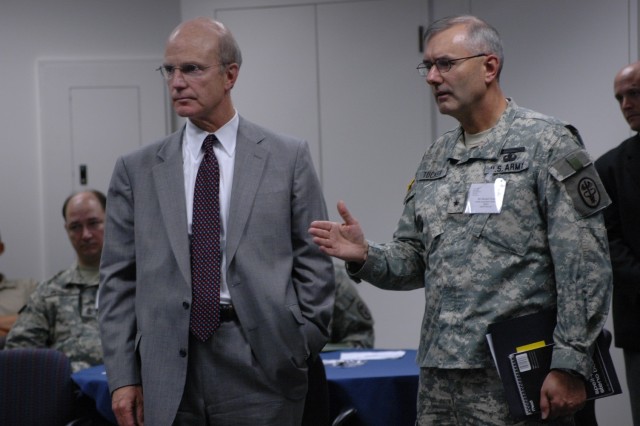WASHINGTON (Army News Service, Oct. 29, 2007) - Every Warrior Transition Unit member must be certified by Jan. 2, said Col. Paul Cordts, director of health policy and services at the Army's Office of the Surgeon General.
He joined leaders from across the Army, Department of Defense and other government agencies who met in Landsdowne, Va., last week to evaluate the progress of the Army Medical Action Plan and determine the program's next steps.
The Army Medical Department Center and School has developed 18 distance-learning modules for WTU cadre to complete in areas like the medical board process, or sensitivity training, which Col. Cordts said is key.
"The Soldiers are not expecting to be injured or ill and neither is their family, so it's very important for every member of the team to be aware that the Soldiers are going through a major transition," Col. Cordts said. It's very disruptive for both the Soldiers and their family, and frankly, it's a high-risk period. That's why we worry about things like suicide in Soldiers in our Warrior Transition Units and alcohol use and drug use, so it's important that members of the team be aware of that."
The distance learning, he added, is only a short-term solution. AMEDD will send mobile training teams to every WTU in the Army by October 2008, after which it will offer classes in San Antonio four times a year.
In the future, each WTU will also have to be certified, and the triad of squad leader, nurse case manager and primary care manager will have to undergo team training to ensure they function efficiently.
Col. Cordts said they are also considering developing a command and control relationship with community-based healthcare organizations that manage Soldiers located across the U.S., and developing remote-care management for WTUs. A WTU based at Fort Lewis, Wash., for example, might handle a Soldier in California. This would be a way to help Soldiers not located near a WTU.
Part of helping Soldiers heal is ensuring they receive the best care possible, and according to Col. Peter Lawson, at strategic planner at the Army G-1, the Army is considering a holistic managed-care plan for Soldiers.
Dr. (Lt. Col.) Marie Dominguez said this means asking the right questions throughout the entire process, from reception to assessment to rehabilitation. The platoon sergeant, nurse case manager, primary care manager and specialists should all ask certain things, and then, she said, sit down with the Soldiers and determine their goals and how to get them there.
"We're setting the Soldier up for success, whether they remain in the service or transition out," she said.
"In the long term, we do not want to turn people back over to the civilian sector without the proper life skills or motivation," added Brig. Gen. Mike Tucker, AMAP director. "This is helping people help themselves, understanding what their capabilities are and setting conditions to allow them to achieve their own potential at a time when they need it the most."
A key element of helping Soldiers is placing them in the best housing available on an installation. At least 10 percent of housing must be handicapped-accessible and all emergency repairs will take place within 24 hours, said Brig. Gen. Tucker.
According to Col. Lisa Hines, deputy chief of staff for the AMAP cell at the Installation Management Command, IMCOM plans seven major construction projects totaling $138 million in fiscal year 2008 and 17 in fiscal year 2009 totaling $790 million.


Social Sharing